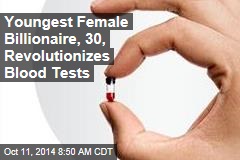| Getting sharp images from dull detectors Posted: 10 Oct 2014 12:52 PM PDT Observing the quantum behavior of light is a big part of Alan Migdall's research at the Joint Quantum Institute. Many of his experiments depend on observing light in the form of photons -- the particle complement of light waves -- and sometimes only one photon at a time, using "smart" detectors that can count the number of individual photons in a pulse. Furthermore, to observe quantum effects, it is normally necessary to use a beam of coherent light, light for which knowing the phase or intensity for one part of the beam allows you to know things about distant parts of the same beam.  |
| Pneumococcal vaccine reduces antibiotic-resistant infections in children by 62 percent Posted: 10 Oct 2014 10:43 AM PDT The pneumococcal vaccine recommended for young children not only prevents illness and death, but also has dramatically reduced severe antibiotic-resistant infections, suggests American nationwide research. Pneumococcal infection -- which can cause everything from ear infections to pneumonia and meningitis -- is the most common vaccine-preventable bacterial cause of death.  |
| Insisting only on randomised controlled trials for Ebola treatments unethical, impractical, say leading health experts Posted: 10 Oct 2014 10:43 AM PDT Leading health experts urge the deployment of alternative trial designs to fast-track the evaluation of new Ebola treatments. Senior health professionals and medical ethicists, from Africa, Europe, and USA, argue that although randomized controlled trials (RCTs) provide robust evidence in most circumstances, the lack of effective treatment options for Ebola, high mortality with the current standard of care, and the paucity of effective health care systems in the affected regions means that alternative trial designs need to be considered.  |
| Physics determined ammonite shell shape Posted: 10 Oct 2014 10:43 AM PDT Ammonites are a group of extinct cephalopod mollusks with ribbed spiral shells. They are exceptionally diverse and well known to fossil lovers. Researchers have developed the first biomechanical model explaining how these shells form and why they are so diverse. Their approach provides new paths for interpreting the evolution of ammonites and nautili, their smooth-shelled distant "cousins" that still populate the Indian and Pacific oceans.  |
| Antiretroviral therapy benefits HIV-infected stimulant users Posted: 10 Oct 2014 10:43 AM PDT 341 HIV-infected men who reported using stimulants such as methamphetamine or cocaine derived life-saving benefits from being on antiretroviral therapy that were comparable to those of HIV-infected men who do not use stimulants, a study concludes.  |
| Mineralization of sand particles boosts microbial water filtration Posted: 10 Oct 2014 08:17 AM PDT Mineral coatings on sand particles actually encourage microbial activity in the rapid sand filters that are used to treat groundwater for drinking, according to a paper. These findings resoundingly refute, for the first time, the conventional wisdom that the mineral deposits interfere with microbial colonization of the sand particles.  |
| Preparing for Mars-grazing Comet Siding Spring Posted: 10 Oct 2014 08:16 AM PDT Up to and during Comet Siding Spring's flyby of Mars on Oct. 19, NASA's Compact Reconnaissance Imaging Spectrometer for Mars will attempt to capture data about the comet that are unobtainable from Earth.  |
| sensor invented that uses radio waves to detect subtle changes in pressure Posted: 10 Oct 2014 07:10 AM PDT A new sensor has been developed by engineers that is made of a special rubber layer between two strips of copper that act like radio antennas; the rubber is an insulator. Pressure squeezes the antennas infinitesimally closer, altering the electrical characteristics of the device. Radio waves beamed through the device change frequency as pressure changes, providing a way to gauge pressure wirelessly. The underlying technology could lead to prosthetic devices with an electronic sense of touch.  |
| Rare 'baby rattle' molecules reveal new quantum properties of H<sub>2</sub>O and H<sub>2</sub> Posted: 10 Oct 2014 07:09 AM PDT Neutron scattering experiments have revealed the existence of quantum selection rules in molecules, the first experimental confirmation of its kind. Small molecules such as water and hydrogen were inserted into C-60 buckyballs to form rare compounds ideal for testing the predictions of quantum theory. Similar confinement techniques could open the door to new insights about the quantum properties of molecules by providing a unique testing ground for quantum theory.  |
| Real-life social networking prompts people to get tested for HIV Posted: 10 Oct 2014 07:09 AM PDT Old-school face-to-face social networking is a more effective way to identify people with HIV than the traditional referral method, suggests research. The study shows that social networking strategies -- enlisting people in high-risk groups to recruit their peers to get tested – is more efficient and targeted than traditional testing and referral programs, resulting in 2-and-a-half times more positive test results.  |
| Potential of autochthonous bacteria for use as biofertilizers Posted: 10 Oct 2014 07:08 AM PDT Scientists are working to select autochthonous bacteria with a biofertilizing potential as a result of the stimulating effect they have on the take-up of nutrients by plants, phytohormone production and phytopathogen control. The research is of great interest for farmers because bacteria-based biofertilizers constitute an alternative to conventional chemical fertilizers that are expensive and less sustainable from an environmental point of view.  |
| Leaky, star-forming galaxies leads to better understand the universe Posted: 10 Oct 2014 07:08 AM PDT Focusing on large, star-forming galaxies, researchers were able to measure radiation leaks in an effort to better understand how the universe evolved as the first stars were formed.  |
| Bowel cancer risk reduced by adopting multiple healthy behaviors Posted: 10 Oct 2014 05:41 AM PDT Adoption of a combination of five key healthy behaviors is associated with a reduction in the risk of developing bowel cancer. Researchers quantified the impact of combined multiple healthy lifestyle behaviors on the risk of developing bowel cancer, and found that this impact is stronger in men than in women.  |
| Elevated cholesterol, triglycerides may increase risk for prostate cancer recurrence Posted: 10 Oct 2014 05:41 AM PDT Higher levels of total cholesterol and triglycerides, two types of fat, in the blood of men who underwent surgery for prostate cancer, were associated with increased risk for disease recurrence, according to a study.  |
| Fast, simple diagnostic test specific to 2014 Ebola outbreak Posted: 10 Oct 2014 05:40 AM PDT Researchers have developed a fast and simple diagnostic test solution specific to the 2014 Ebola outbreak. With the current epidemic of Ebola virus in West Africa, scientists are racing to provide an easy-to-use, affordable solution for screening suspect Ebola patients.  |
| Middle Eastern vegetation resistant to climate change: Ecosystems withstand more than seven lean years Posted: 10 Oct 2014 05:40 AM PDT Ecosystems in the Middle East are home to a wealth of unique species -- including the ancestors of many of our staple crops. Yet the climate scenario in this dry region is alarming. Already, the region has a relatively small amount of water available for every person living there -- and it is predicted that in the future, there will be even less rain. New research shows that Middle Eastern ecosystems might be more resilient than previously thought.  |
| Mechanism that repairs brain after stroke discovered Posted: 10 Oct 2014 05:38 AM PDT A previously unknown mechanism through which the brain produces new nerve cells after a stroke has been discovered by researchers. A stroke is caused by a blood clot blocking a blood vessel in the brain, which leads to an interruption of blood flow and therefore a shortage of oxygen. Many nerve cells die, resulting in motor, sensory and cognitive problems. The researchers have shown that following an induced stroke in mice, support cells, so-called astrocytes, start to form nerve cells in the injured part of the brain.  |
| Old textbook knowledge reconfirmed: Decay rates of radioactive substances are constant Posted: 10 Oct 2014 05:38 AM PDT Researchers refute the assumption that the decay rate of some radioactive nuclides depends on the distance between the Earth and the Sun.  |
| Two-generation gender equality study shows career benefits for men Posted: 10 Oct 2014 05:38 AM PDT Couples in a research experiment launched in the 1970s shared the responsibility for home, family and work equally. Now, 30 years later, a follow-up study shows that the couples' strive for equality was beneficial not only for the family life but also for the fathers' careers. Despite this their sons, now themselves parents, have not chosen the same path.  |
| New technique enables increasingly accurate PET scan to detect cancer, heart conditions Posted: 10 Oct 2014 05:38 AM PDT A novel technique that reduces image degradation caused by respiratory motion during a PET scan was developed through a recent study. PET scanning is routinely used to detect cancer and heart conditions. The new technique is based on bioimpedance measurement and it allows for image reconstruction at a specific phase of the patient's breathing pattern. This, in turn, makes it possible to reduce image degradation caused by motion.  |
| Fish moving poleward at rate of 26 kilometres per decade Posted: 10 Oct 2014 05:38 AM PDT Large numbers of fish will disappear from the tropics by 2050, finds a new study that examined the impact of climate change on fish stocks. The study identified ocean hotspots for local fish extinction but also found that changing temperatures will drive more fish into the Arctic and Antarctic waters.  |
| Scientists create mimic of 'good' cholesterol to fight heart disease, stroke Posted: 10 Oct 2014 05:37 AM PDT A synthetic molecule that mimics "good" cholesterol has been developed and has shown that it can reduce plaque buildup in the arteries of animal models. The molecule, taken orally, improved cholesterol in just two weeks.  |
| Hormone loss could be involved in colon cancer Posted: 10 Oct 2014 05:37 AM PDT Like diabetes, colon cancer may be caused in part by the loss of one hormone, suggesting hormone replacement therapy could stall cancer formation. New evidence suggests that human colon cells may become cancerous when they lose the ability to produce a hormone that helps the cells maintain normal biology. If verified by further studies, it suggests that treating patients at high risk for colon cancer by replacing the hormone guanylin could prevent the development of cancer.  |
| Electrically conductive plastics promising for batteries, transparent solar cells Posted: 09 Oct 2014 06:04 PM PDT An emerging class of electrically conductive plastics called 'radical polymers' may bring low-cost, transparent solar cells, flexible and lightweight batteries and ultra-thin antistatic coatings for consumer electronics and aircraft.  |
| Radio frequency technology being developed to localize breast tumors Posted: 09 Oct 2014 06:03 PM PDT Breast cancer may inspire more public discussion, advocacy and charitable giving than almost any other disease besides HIV and AIDS. But people rarely talk about the specific experiences to which cancer patients are subjected. Especially the localization wire. For a group of engineers and clinicians, that presented an opportunity to develop a solution that is technologically elegant, precise and patient-centric.  |
| DNA nano-foundries cast custom-shaped metal nanoparticles Posted: 09 Oct 2014 12:41 PM PDT Researchers have unveiled a new method to form tiny 3-D metal nanoparticles in prescribed shapes and dimensions using DNA, nature's building block, as a construction mold. The ability to mold inorganic nanoparticles out of materials such as gold and silver in precisely designed 3D shapes is a significant breakthrough that has the potential to advance laser technology, microscopy, solar cells, electronics, environmental testing, disease detection and more.  |
| Ebola vaccine trails beginning in Mali Posted: 09 Oct 2014 12:41 PM PDT Medical researchers have begun a clinical trial in health care workers and other front-line workers to evaluate a promising experimental Ebola vaccine.  |
| Quantifying physical changes in red blood cells as they mature in the bloodstream Posted: 09 Oct 2014 12:40 PM PDT During their approximately 100-day lifespan in the bloodstream, red blood cells lose membrane surface area, volume, and hemoglobin content. A new study finds that of these three changes, only the observed surface-area loss can be explained by RBCs shedding small hemoglobin-containing vesicles budding off their cells' membrane.  |
| Lung cancer can stay hidden for over 20 years Posted: 09 Oct 2014 12:40 PM PDT Scientists have discovered that lung cancers can lie dormant for over 20 years before suddenly turning into an aggressive form of the disease.  |
| Entire female reproductive tract susceptible to HIV infection in macaque model Posted: 09 Oct 2014 12:40 PM PDT Most women are infected with HIV through vaginal intercourse, and without effective vaccines or microbicides, women who cannot negotiate condom use by their partners remain vulnerable. How exactly the virus establishes infection in the female reproductive tract remains poorly understood. A new study reports surprising results from a study of HIV transmission in the FRT of rhesus macaques.  |
| Embryos receive parent-specific layers of information, study shows Posted: 09 Oct 2014 12:40 PM PDT The information that interprets the genetic code in a new embryo differs depending on whether it comes from the father or mother, researchers have found. This parent specific information is contained within modified histone proteins, also called 'epigenetic marks,' which influence the development plan of new embryos. The research opens up new avenues of study for scientists exploring the process of how genetic information is passed from parents to offspring.  |
| Does my child need a flu shot or not? Posted: 09 Oct 2014 12:38 PM PDT It's a common question parents ask themselves this time of year: Does my child really need a flu shot? Though the flu may seem harmless, the truth is on average 20,000 children age 5 and younger are hospitalized due to flu symptoms each year.  |
| Computer science: 'Data smashing' could unshackle automated discovery Posted: 09 Oct 2014 09:56 AM PDT Computing researchers have come up with a new principle they call 'data smashing' for estimating the similarities between streams of arbitrary data without human intervention, and without access to the data sources.  |
| Hunger games: How the brain 'browns' fat to aid weight loss Posted: 09 Oct 2014 09:55 AM PDT A molecular process in the brain known to control eating that transforms white fat into brown fat has been uncovered by researchers. This process impacts how much energy we burn and how much weight we can lose, they report.  |
| Thanks, fruit flies, for that pleasing beer scent Posted: 09 Oct 2014 09:55 AM PDT The familiar smell of beer is due in part to aroma compounds produced by common brewer's yeast. Now, researchers have discovered why the yeast (formally known as S. cerevisiae) make that smell: the scent attracts fruit flies, which repay the yeast by dispersing their cells in the environment.  |
| Gene that drives aggressive brain cancer found by new computational approach Posted: 09 Oct 2014 09:49 AM PDT Using an innovative algorithm that analyzes gene regulatory and signaling networks, researchers have found that loss of a gene called KLHL9 is the driving force behind the most aggressive form of glioblastoma, the most common form of brain cancer.  |
| 'Good' fat that fights diabetes discovered by scientists Posted: 09 Oct 2014 09:49 AM PDT A new class of lipids in humans that is linked to reduced inflammation and improved blood sugar levels in diabetes has been uncovered by researchers. Lipids, like cholesterol, are typically associated with poor health. But in recent years, researchers have discovered that not all lipids are bad for you, such as the much touted omega-3 fatty acids that are found in fish oils.  |
| Special chromosomal structures control key genes Posted: 09 Oct 2014 09:49 AM PDT Scientists have long theorized that the way in which the roughly three meters of DNA in a human cell is packaged to fit within a nuclear space just six microns wide, affects gene expression. Now, researchers present the first evidence that DNA structure does indeed have such effects -— in this case finding a link between chromosome structure and the expression and repression of key genes.  |
| Chemists uncover new role of a key base in organic synthesis Posted: 09 Oct 2014 08:27 AM PDT An international team of chemists has discovered a new piece to the puzzle of how a powerful base used in organic synthesis, cesium carbonate, plays a pivotal role during a catalytic reaction.  |
| All that glitters is... slimy? Gold nanoparticles measure stickiness of mucus in airways Posted: 09 Oct 2014 08:27 AM PDT Researchers have developed a way to use gold nanoparticles and light to measure the stickiness of mucus in the airways. Their research could help doctors better monitor and treat lung diseases such as cystic fibrosis and chronic obstructive pulmonary disease.  |



























